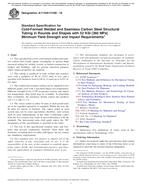1.1 These test methods cover the chemical analysis of clays used in the manufacture of ceramic whitewares.
1.2 The analytical procedures appear in the following order:
Note 1
These test methods have been compiled as standard procedures for use in referee analyses. These test methods, however, when the determination of iron oxide as Fe
It will be understood that the making of a complete analysis of a ceramic whiteware clay is a difficult procedure requiring a wide knowledge of the chemistry involved in the operations and a thorough training in carrying out the work. A skilled analyst of good training is therefore required to do the work. The descriptions here given cover the vital points of procedure, but frequent reference in regard to the details of the various manipulations should be made to “Applied Inorganic Analysis” by Hillebrand and Lundell and to similar publications. Particularly in the determination of alumina, reference should be made to Scientific Paper No. 286 of the National Bureau of Standards.
1.3 The values stated in acceptable metric units are to be regarded as the standard. The values given in parentheses are for information only.
This standard does not purport to address all of the safety concerns, if any, associated with its use. It is the responsibility of the user of this standard to establish appropriate safety and health practices and determine the applicability of regulatory limitations prior to use.
Product Details
- Published:
- 02/15/2006
- Number of Pages:
- 5
- File Size:
- 1 file , 93 KB


